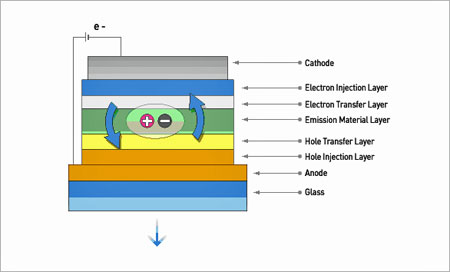
• Mechanism of OLED Device
When power is supplied, electrons move and the current begins to flow: Electrons(-) from the Cathode move toward the Emitting Layer by the help of the Electron Transfer Layer, on the other hand, Holes(+: state of electrons released) from the Anode move toward the Emitting Layer by the help of the Hole Transfer Layer.
Electrons and Holes converged at the Emitting Layer of organic materials generate excitation with high level of energy when the excitation falls down to the lower energy state creating light.
The color of the light varies according to the organic materials forming the Emitting Layer, and Full color can be represented by each organic material emitting R,G,B colors. Contrary to LCD with the simple function of open/closing pixels, OLED utilizes self light-emitting organic materials.
• Representative sample of OLED Materials
Hole Injection Material - OSA3847, OSD6815, OPB9241
Hole Transport Materials - OSC7534(NPB), OSA3939(MTDATA), OSA7140, OSA3251(DCBP)
Electron Transport / Hole Blocking Materials - OSA2480(TAZ), OPA1957, OPA1854
Host Materials - OSD4487(AlQ3)
Doped Host Materials - OSA9530(DPQA), OPA5719(DCM2), OPA1790, OSA1762
Polymeric & Small Molecule Light Emitting Materials - OHA9576(MEH-PPV), OSA7983 (DPVBi), OPA6495, OPA5632
All technical information we supply is based on our general experience and is given in good faith. It is always the user’s responsibility to evaluate the feasibility of using our products by carrying out trials under actual production conditions before proceeding with a commercial run.

.jpg)